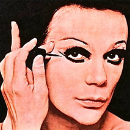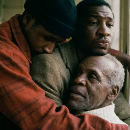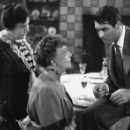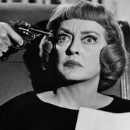CRUCIAL VIEWING
William Wyler’s COUNSELLOR AT LAW (American Revival)
Chicago Film Society (at Northeastern Illinois University, The Auditorium, Building E, 3701 W. Bryn Mawr Ave.) — Wednesday, 7:30pm
Elmer Rice, author of the play Counsellor at Law as well as its screenplay who had a successful writing career in the theater, was lucky to find his perfect director in William Wyler for the film version of this legal drama. A rarity among Hollywood directors, Wyler respected the words on the page and did little to shape them into an auteurist vision. His self-described mission was to entertain and make a lot of money; a stance on filmmaking that sent his star plummeting from the skies when the mid-century French critics anointed a canon of auteurs that expressly excluded him. The fact that Wyler was content to be a showman did not preclude him from having a few expressive tics that show themselves in COUNSELLOR AT LAW, a stagebound film that nonetheless allowed him to showcase some truly dazzling dialogue. Further, sharing a Jewish background with Rice allowed Wyler to coach the miscast patrician John Barrymore to a halfway believable performance as a Jewish lawyer whose Lower East Side roots make his marriage to a blueblood with two children a decidedly lopsided alliance. COUNSELLOR AT LAW has the fast pace and snappy humor of a screwball comedy. A controlled chaos within the office conveys the rapid-fire business of the successful law practice of George Simon (Barrymore) and John Tedesco (Onslow Stevens). Two Italian clients wait for Tedesco, peppering the dialogue with their native language. Several people want to see Mr. Simon, including Zedorah Chapman (Mayo Methot), whom Simon has just defended successfully in a murder trial; Sarah Becker (Malka Kornstein), a friend from the old neighborhood who wants Simon to defend her son Harry (director-to-be Vincent Sherman), who has been roughed up and arrested by the cops for making pro-Communist speeches; and Charlie McFadden (John Hammond Daily), a process server and investigator Simon rescued from a life of crime. In one of his characteristic flourishes, Wyler teases the audience like another client waiting in line by keeping Simon out of sight; our lead-up to the “reveal” is Barrymore’s hands working the phones on his desk. When Barrymore finally appears, it seems designed to encourage applause, a nod to the stage origins of the film. Over-the-shoulder shots with delayed reaction shots, a Wyler staple, also dot COUNSELLOR AT LAW. The most effective one shows Harry standing, his fist clenched, when he hears George’s snobbish stepchildren (Barbara Perry and future director Richard Quine) disparage the working class. When we finally do see his beaten face wild with anger, Wyler switches to the children and moves slowly in on their frightened faces. Among the clichés of the script is Simon’s hard-working, ultra-efficient secretary “Rexy” Gordon (Bebe Daniels), a beautiful young woman whose unrequited love for her boss plays out with beautifully modulated distress and growing agitation that make her scenes a somewhat harrowing experience. Many small comic moments brighten the film. For example, middle-aged, ample secretary Goldie Rindskopf (Angela Jacobs) moves languidly through the office, her broad beam a vision of delight for the two Italians and a thoroughly refreshing, if superficial look at the sex appeal of an older woman. Rice studied and practiced law for a short while, and his jaundiced view of the profession, from the emotional tricks and fake alibis that help lawyers get criminals acquitted, to the lobbying on behalf of big business and the flexible fees to cover losses, gets a full airing in the actions of George Simon. Class conflict is also well represented in the scenario, but anti-Semitism is only vaguely alluded to. Nonetheless, George Simon remains a fairly sympathetic character, and the subtext of presumed Aryan superiority represented by George’s wife and her set gives this film the kind of meat a thorough professional like Wyler could sink his teeth into. Preceded by George Marshall’s 1932 short THE SOILERS (18 min, 35mm archival print). (1933, 82 min, 35mm) MF
Alfred Hitchcock’s SHADOW OF A DOUBT (American Revival)
Gene Siskel Film Center - Friday, 4pm and Tuesday, 6pm
One of Alfred Hitchcock’s greatest strengths as a storyteller is his ability to reveal information within his films that clues the audience to the realities of the situation while simultaneously withholding this information from his characters. Not only does this drive the plot but also adds a combination of both hope and dread that these secrets might not come to a nefarious fruition for the characters the audience has recently become attached to. In SHADOW OF A DOUBT, he seeks to do exactly this. Teenaged Charlie (Teresa Wright) lives in a small town in California with her mother leading a rather disenchanted life when one day her Uncle Charlie (Joseph Cotten) comes to visit. Charlie has always idolized her Uncle, after whom she’s named. When two men claiming to be national surveyors and photographers come to pay a visit at her mother’s home, Charlie starts to suspect her Uncle is not what he seems and begins to fear the worst. Hitchcock deftly blends the idyllically shot Santa Rosa and deep family nostalgia with the slowly creeping realization that kin might not always be what they appear to be to create a disquieting feeling that on the surface may loom cheerful but is laden with unsavory subtext beneath. The internal turmoil felt by Charlie is peak Hitchcock even if the film undeservedly continues to hold a less prominent place in his oeuvre. Cited as a personal favorite of the director among his own works, SHADOW OF A DOUBT is a subversive thrill ride. Critic and artist Fred Camper lectures at the Tuesday screening. (1943, 108 min, 35mm) KC
Bettina Perut and Iván Osnovikoff’s LOS REYES (New Documentary)
Gene Siskel Film Center – Check Venue website for showtimes
“Joyful, joyful, joyful / As only the dogs know how to be happy / with only the autonomy / of their shameless spirit.” The words of Chilean poet Pablo Neruda might have been penned for Football and Chola, the canine protagonists of Bettina Perut and Iván Osnovikoff’s documentary LOS REYES. Fellow Chilenos Perut and Osnovikoff discovered the pair—the former a big fluffy mutt, the latter a frolicsome Labrador—while filming a portrait of skateboarders in Santiago’s Los Reyes skatepark, and let their focus wander to capture the day-to-day existence of the affable strays. Such unencumbered souls must be a dream to follow, letting the filmmakers translate the spontaneity of their subjects into a playful yet captivated gaze, a form of attention perfectly attuned to both open-ended games and closed-eye reverie. (Documentary students struggling to come to grips with the stochasticity of observational filmmaking should find LOS REYES especially inspiring.) There are a few grand set-pieces, such as a rainstorm that leaves Football and Chola drenched in solitude, or the comically sudden transformation of the skate park into a fenced-in, no-dogs-allowed sports venue. Mostly, however, the action is minimal, a lulling series low-stakes encounters with tennis balls, sprinklers, and passing cyclists. Though they’ve pried their gaze away from the young pot-smokers, shredders, and dreamers who also frequent the skatepark, Perut and Osnovikoff retain their extended dialogues on the soundtrack, offering a profane and vibrant human counterpoint that sometimes dips over the edge into contrivance—to clumsily borrow skater lingo, the juxtaposition occasionally comes off as more tech than cruise. The film is at its most inspired when Perut and Osnovikoff untether their curiosity from human scale, collecting both vast panoramas of the Santiago skyline and macrophotographic enlargements of single insects cohabiting in nests of fur. These dilations help combat accusations of anthropomorphism, but they also situate these human and animal lives within biological and societal structures, proving that LOS REYES offers nothing so simple as a dog’s eye view of the world. Just as deft editing corrals this shaggy doc with subtle thematic and narrative threads, laws both natural and cultural constrain the autonomy of the film’s human and animal subjects. These tensions, between the uninhibited curiosity of the film’s photography and the precise order of its montage, between the freedom promised within the skatepark and the harsh realities that surround it, mark LOS REYES as in fact a deeply human film. Though joyful, it is also unexpectedly elegiac—sharing the same sense of irony that led Neruda to proclaim, “I'll not speak of sadness here on earth,” while offering a lament for a dead dog that is thick with grief. LOS REYES is ultimately a poignant work of observation, speaking to ineluctable truths about death and the loss of innocence held just outside the frame. (2018, 78 min, DCP Digital) MM
Frank Simon's THE QUEEN (Documentary Revival)
Music Box Theatre - Check Venue website for showtimes
Difficult to find until quite recently, this legendary documentary focuses the limelight on a remarkable time in queer history: that of drag culture on the cusp of something like mainstream popularity and recognition. In New York in the late 1960s, drag culture was already a staple of nightlife for gay men and those in the arts scene, but was still considered something of the "underbelly" to other New Yorkers, and was virtually unknown to the world-at-large. Frank Simon, co-producing with the film's narrator, Flawless Sabrina (aka Jack Doroshow), and Andy Warhol, who greatly assisted in raising funds for THE QUEEN, shot the film in five days, with five cameras, using only verité footage and Sabrina's witty and occasionally biting narration to give a riveting, behind-the-scenes glimpse of the New York Finals, a national pageant judged by Warhol himself, as well as other notables of the day, including artist Larry Rivers (Judy Garland, who had judged several of Sabrina's pageants in the past, dropped out when she heard the 1967 pageant was being shot as a documentary.). Warhol's friend Mario Montez also makes an appearance singing an extra-campy rendition of "Diamonds Are a Girl's Best Friend." The pageant gained notoriety for a variety of reasons, and ultimately the documentary became a surprise hit in 1968, with a favorable review in the New York Times, screenings in major cities across the country, and even a screening at Cannes, marking the beginning of mainstream awareness of not only the drag subculture, but gender variance and the as-yet-unnamed trans movement. Yet that historical notoriety takes second stage to the most fascinating and beautifully shot moments of the documentary. In the hotel rooms shared by the contestants, the queens lounge together before rehearsals, help each other prepare makeup and costumes, share a glass of scotch, and offhandedly relate stories of coming out, being rejected from the draft (I won't ruin the laugh by quoting some of the stories here; the delivery is everything, if you've ever heard a drag queen read anybody.), and whether or not they would undergo the (until 1966, unavailable) sex-change surgery if they had the money. Hearing these candid discussions highlights just what a strange time it was in trans and queer history, before identity politics, before hormones, before the term genderqueer; it was a time of gender and sexual fluidity before identities and possibilities had solidified, and a time when drag was the only way for some to express their felt gender and perform in ways that made them feel truly free. This documentary even provides the fabled genesis of the ballroom scene memorialized in PARIS IS BURNING: black contestant Crystal LaBeija went on to found the first official House of LaBeija in the ballroom scene after losing dramatically to Miss Harlow, a protégé of Flawless Sabrina, and delivering a blistering reading backstage. (1968, 68 min, DCP Digital) AE
Nick Broomfield’s MARIANNE & LEONARD: WORDS OF LOVE (New Documentary)
Gene Siskel Film Center — Check Venue website for showtimes
Life is but a dream, as the poets tell us. As if in a vision, Marianne bobs on a sailboat in the Aegean Sea off the Greek island of Hydra, with the sunlight warming her shoulders. And she is happy. Leonard Cohen, her partner, is there. It's before his singing fame; he's just a struggling young poet and aspiring novelist. They are in their twenties. Flash forward nearly six decades: it's 2016, and an elderly Marianne is on her deathbed when a letter from Leonard famously arrives. "Dearest Marianne," he writes, "I'm just a little behind you, close enough to take your hand." Leonard dies a few months later. This is a well-known story, and one that MARIANNE & LEONARD: WORDS OF LOVE, an intensely moving, elegiac, and deeply personal documentary by Nick Broomfield, deepens and complicates. Marianne Ihlen was a Norwegian woman, almost always described as Leonard's "muse/lover," who inspired some of his greatest songs when they lived together in the bohemian artists' refuge of Hydra. Broomfield himself arrived on the island as a 20-year-old, and was briefly Marianne's lover himself, he tells us. The sun-drenched footage of young Marianne has the golden, slightly faded magic of a memory, or a dream. Yet Leonard had to keep going back to Montreal to see "real life," and after 1967, they were increasingly off-again as a couple, as Leonard's career as a singer took off. The movie shows how their bond endured nevertheless, toggling between Leonard's career and Marianne's thoughts and feelings, even as she returned to Oslo to lead a "normal," private life. Broomfield finds good interviewees. I especially got a kick out of Ron Cornelius, a raconteur with a folksy drawl, who slyly recounts his adventures touring with Leonard, including a great story about playing a mental asylum. There's footage of a concert that turns into an onstage love-in. There's Marianne in the front row at a concert in Oslo, from that glorious comeback tour that began in 2008, singing along with So Long, Marianne. I do believe it's fair to say we wouldn't have anything like what we think of as Leonard Cohen's body of work without her. I don't merely mean that she was an inspiration, though she was certainly that. It's that she provided him a stable, nourishing existence. Is it feminist or not to honor Marianne's role as essentially the Giving Tree, to posit women's contributions as muses as a form of creation, indirect or no? Interestingly, Marianne was a muse for at least one woman, as well: the folksinger Julie Felix. Felix, who's all about "woman power," celebrates Marianne and defines the muse as the one who loves and nurtures, who makes what the artist does possible. The vision of the creative life on a Greek island is powerfully appealing to me. Marianne talks about life there: we sat in the sun, listened to music. There was writing, lovemaking, swimming, lots of retsina, and "Leonard was beautiful." However, Broomfield is clearly powerfully conflicted about Hydra. A lot of the artists who went there, it ended up destroying them somehow. MARIANNE & LEONARD doesn't shy away from showing the pain, the selfishness, the hurt feelings, the damage done. I admired the way the film captured Leonard's empathy and compassion and soulfulness, his lifelong quest to learn, but it's a dark portrait, as well. As a young man, he embraced wrongness in all the hoary ways of the male artist. Leonard's old age coincided with a time in my life when I faced a certain amount of challenges, and his music was, for me, a tremendous source of consolation and strength and courage. This was the Leonard who'd come down from Mt. Baldy. In a way, he was a very different man than the one we see in this film. By then, he'd found a way through the suffering and depression, a certain amount of peace, and grace, and acceptance, too. There is a crack in everything: we are all flawed. Broomfield is certainly the right man to tell this very unconventional love story, because he knew Marianne so well. At the same time, I'm sure these lives were even more complicated than what we see here. To Broomfield's credit, the film never really strays too far from Marianne. We hear a lot of her voice—I'd wager nearly as much as we do Leonard's. We hear their voices, telling us of a time when they were young and happy on their island in the sea, about those beautiful days when they felt truly alive, and everything seemed possible. Some of these images resonate like the afterglow of a dream, a loving memory preserved, one that was never forgotten even unto the end. (2019, 102 min, DCP Digital) SP
Edmund Goulding’s DARK VICTORY (American Revival)
Music Box Theatre — Saturday, Sunday, and Monday, 11:30am
n his book Edmund Goulding’s Dark Victory, Matthew Kennedy remarks about Goulding's film DARK VICTORY “If it all seemed a bit overheated, [Bette] Davis and the cast pulled it off by refusing to recognize the implausibility of the plot,” a consideration that’s applicable not just to this film and its stars, but also to its director and perhaps even much of his career. (See, for example, his earlier masterpiece GRAND HOTEL.) One of the many great films made in 1939, DARK VICTORY is an exemplar of conviction, so earnest in its melodrama that it transcends both the term and the woman's picture genre, universal is its vigor. Its pedigree is vast; adapted from the eponymous 1934 Broadway play starring Tallulah Bankhead, it was later adapted for radio with Barbara Stanwyck and Melvyn Douglas as the leads. Producer David O. Selznick was originally interested in adapting the play, having several stars in mind for the ailing protagonist, including Greta Garbo and Merle Oberon. Eventually, however, Davis convinced Warner Bros. to buy it from him, with the help of Goulding, whom she called “one of the few all-time great directors of Hollywood.” Davis plays Judith Traherne, a hedonistic, horse-loving Long Island socialite who, with the help of Dr. Frederick Steele (George Brent—he and Davis made eleven films together and had an off-screen affair), discovers that she’s severely ill. Steele operates, but the prognosis, brain cancer, is terminal. Rather than tell Judy, he and her best friend, Ann (Geraldine Fitzgerald), decide to keep it a secret, Judy having gained a newfound zest for life, her affection for Steele soon turned into a real relationship—that is, until she learns she’s still sick and has only months to live. After some melancholy indulgence and a brief dalliance with her horse trainer (played by a pre-stardom Humphrey Bogart), she returns to Steele to live out her days happily. They marry, but the end is most certainly nigh, as is conveyed in a brilliant finale that justifies both its critical accolades and its status as a “three-hanky” tearjerker. Davis is compelling as always, the role garnering her third of ten Oscar nominations, though each cast member—from Brent to Fitzgerald (whose character Goulding added as a sort-of Greek chorus, reflecting Judith’s grief so that she “would not have to cry for herself”) to even Bogart and Ronald Reagan, as Judy's friend Alec—commits to their role in the implausible scenario with such finesse that at no point does one feel compelled to stop and think, This...is absurd. Rather, one is drawn into the intensity and placated by Goulding’s deft handling of it, his fervor justifying our own. (1939, 104 min, 35mm) KS
ALSO RECOMMENDED
T.A. Manchester’s BLEED AMERICAN (New American)
Classic Cinemas (1022 Lake Street, Oak Park) – Thursday, 7pm
A film about disaffected youth in the tradition of Jonathan Kaplan’s OVER THE EDGE, Tim Hunter’s RIVER’S EDGE, and Larry Clark’s KIDS, but given a refreshingly Midwestern (specifically northern Indiana) Trump-era spin, T.A. Manchester’s impressive second feature as writer/director is as raw as an open wound. In a concise 75 minutes, Manchester follows a group of blue-collar teens living without parental guidance in trailers and drab apartments in a bleak stretch of the Rust Belt as they alternately attempt to forge meaningful emotional and sexual bonds with one another, goof off, party and, ultimately, just eke out a daily existence. The main focus is on Larson (Jarret Maier), a lanky, brooding young man who struggles to play a paternal role to his confused younger siblings, LJ (Austin Holloway) and Lex (Madison Wolters), in the wake of their mother's chronic illness and father's absence, and the film’s narrative aimlessness is an apt reflection of the characters’ rudderless lives. It’s an assured piece of filmmaking shot in a gritty, quasi-documentary style: Manchester and cinematographer Mario Quintana are especially resourceful using wide-angle lenses in cramped spaces, and one dialogue scene in a car is a virtuoso piece of mise en scene. There’s plenty of talent lurking in the ensemble cast too but the female characters are given short shrift by being defined primarily for how they stir feelings in male counterparts with considerably more screen time. This is regrettable since Elizabeth Stam and Emily Eruraviel are compelling performers who tend to steal the scenes they’re in; but BLEED AMERICAN is, on the whole, a potent American indie about youth today that marks Manchester as a filmmaker to watch. Manchester, producer John Matzler, cinematographer Mario Quintana, and several cast members in person. (2019, 75 min, DCP Digital) MGS
Jennie Livingston’s PARIS IS BURNING (Documentary Revival)
Gene Siskel Film Center — Check Venue website for showtimes
Almost three decades have passed since the release of PARIS IS BURNING and Jennie Livingston’s poignant documentary is still deeply relevant. Following drag queens and performers in the New York City ballroom scene, Livingston gives her subjects the space to do the bulk of the talking, walking, and posing. It’s both intimate and unobtrusive—managing to strike an exceptionally difficult balance for a debut documentary feature. PARIS IS BURNING captures the enthusiasm and character of “house” balls: from the many kinds of performance competitions, to the costumes, and the energy that exudes from everyone in front of the lens. But PARIS IS BURNING does not paint an overly gaudy portrait, either. There is glitz and glamour, sure, but there is also immense pain—often from the loss of loved ones to the AIDS crisis and transphobic, homophobic violence. While PARIS IS BURNING has been critiqued over the years, it is still a fundamental text in the queer cinematic canon; both as an authentic documentation of queer life and as an introduction to vital fragments of queer history and culture that should not be forgotten. (1991, 71 min, DCP Digital) CC
Quentin Tarantino’s ONCE UPON A TIME… IN HOLLYWOOD (New American)
Music Box Theatre – Check Venue website for showtimes
Having finally arrived, Quentin Tarantino’s ONCE UPON A TIME… IN HOLLYWOOD could not be any truer to its creator’s decades-long fascination and obsession with 1960’s and 70’s cinema, though it also feels slightly atypical for the director. Without giving anything away, the long blocks of back-and-forth dialogue that Tarantino usually indulges in have begun to give way to more preoccupation with staging, fourth-wall-breaking camera moves, and all around color, resulting in an ambling and evocative dreamscape rife with a whole host of characters. Atmosphere has never been so palpable and dialogue between characters so natural in a Tarantino film—there’s nary a monologue in sight. The film begins at the tail end of an era in Hollywood filmmaking in which rapidly-fading TV actor/cowboy “heavy" Rick Dalton (Leonardo DiCaprio) is seeing his career head towards Italy, specifically towards the cheap and fast genre films of Sergio Corbucci. Burt Reynolds went to Rome to work with Corbucci, Eastwood did the same for Sergio Leone, along with character actors like Lee Van Cleef, and so did one-time TV western stars like Ty Hardin (Rick Dalton is probably most similar to the latter). In the cases of Reynolds and Eastwood, their careers were revitalized by the Italian industry, but many others, like Hardin, were pushed further into obscurity. While watching his star power sputter out in what he perceives to be his twilight years, Dalton is accompanied by his sidekick/assistant/stunt man/reflective image Cliff Booth (Brad Pitt), who lives in a trailer behind a drive-in theater, while Dalton lives in a Benedict Canyon home (with pool, naturally). He lives next door to Roman Polanski and Sharon Tate (Margot Robbie), and Manson family members are prowling around the streets of L.A., hollering at police officers and offering up blowjobs while they try to hitch back to their nesting grounds at the Spahn Ranch. Tarantino covers a lot of ground in ONCE UPON A TIME—an entire landscape of stories is on view, not dissimilar to something like Robert Altman’s NASHVILLE or even Richard Linklater’s DAZED AND CONFUSED. The film has a near three-hour running time, but three hours that have never seemed so short and compact in recent film memory. The movie has a blink-or-you’ll-miss-it pace, rare for a director who sometimes has a tendency to halt the rush of his work with overly bravura dialogue sequences. Tarantino seems to find fresh new ground within his already steadfast movie-making abilities, to let the scope of his powers extend further than previously thought possible. He barely pauses for the chance to show off his noted screenwriting abilities, and instead chooses to craft an ensemble work that somehow feels more epic than any of his films have ever felt; this is Los Angeles completely transformed back to the summer of 1969, in a way that only a very large budget and large talent could realize. It might possibly be one of the last times we see Hollywood bankroll such an ambitious project, by an auteur still powerful enough to retain final cut. ONCE UPON A TIME isn’t as cynical a look at Hollywood as other films have been (such as Altman’s THE PLAYER—even though it does share a curious opening shot). It’s more bittersweet nostalgia, and is perhaps Tarantino’s breeziest and best work to date; his entire career as a director bursts forth as both a marvelously crafted time-capsule and a fantasy-land-rendering of a mythical Hollywood, specifically the place where dreams, however real, are made. (2019, 165 min, 70mm/35mm/DCP Digital) JD
MORE SCREENINGS AND EVENTS
The Midwest Independent Film Festival (at the Landmark’s Century Centre Cinema) screens Collin Schiffi’s 2018 film ALL CREATURES HERE BELOW (91 min, Digital Projection) on Tuesday at 7:30pm, with Schiffi in person. Preceded by a 6pm networking reception and a 6:30pm panel.
The Beverly Arts Center screens Chicagoland Shorts Vol. 5 (2017-19, approx. 78 min, Digital Projection) on Wednesday at 7:30pm. The curated program of local work includes films by Jennifer Boles, Jiayi Chen and Cameron Worden, Lonnie Edwards, Meredith Leich, Sebastián Pinzón Silva, Ashley Thompson, and Marisa Tolomeo.
Media Burn, Chicago Film Archives, and the Chicago Film Society present At Home in Humboldt on Saturday at 9:30, an outdoor screening at Humboldt Park (east side of the park, on the lawn near the boat house). Screening are a selection of archival, found, and home movies shot around the neighborhood from the 1970s to the present. Free admission.
Also at the Gene Siskel Film Center this week: Shunji Iwai’s 2015 animated Japanese film THE CASE OF HANA & ALICE (99 min, DCP Digital) plays for a week; Sergei Bondarchuk’s 1967 Soviet film WAR AND PEACE (434 min total, DCP Digital) screens in four parts over Saturday and Sunday; and Daniel Vigne’s 1982 French film THE RETURN OF MARTIN GUERRE (113 min director’s cut, DCP Digital) is on Sunday at 5:45pm, Monday at 3pm, and Thursday at 6pm.
Also at the Music Box Theatre this week: Victor Kossakovsky’s 2019 documentary AQUARELA (90 min, DCP Digital) opens; and Adam Krause’s 2018 film GAGS THE CLOWN (100 min, DCP Digital) is on Friday and Saturday at Midnight and Tuesday at 8pm, with Krause in person at the Friday and Tuesday screenings.
At Facets Cinémathèque this week: Roberto Minervini’s 2018 Italian/US/French documentary WHAT YOU GONNA DO WHEN THE WORLD’S ON FIRE? (123 min, Video Projection) and Denis Delić's 2018 Polish/UK film SQUADRON 303 (115 min, Video Projection) have week-long runs.
Garret Price’s 2019 documentary LOVE, ANTOSHA (93 min, DCP Digital) opens at the Landmark’s Century Centre Cinema.
The Chicago Cultural Center hosts the Cinema/Chicago screening of Fabio Meira's 2017 Brazilian film TWO IRENES (89 min, Video Projection) is on Wednesday at 6:30pm. Free admission.
The Chicago Onscreen Local Film Showcase, presenting Chicago-made films in various Chicago Park District locations around the city continues through Saturday. Free admission. Visit www.chicagoparkdistrict.com for the schedule.
CINE-LIST: August 30 - September 5, 2019
MANAGING EDITOR // Patrick Friel
ASSOCIATE EDITORS // Ben Sachs, Kathleen Sachs, Kyle A. Westphal
CONTRIBUTORS // Cody Corrall, Kyle Cubr, John Dickson, Alexandra Ensign, Marilyn Ferdinand, Michael Metzger, Scott Pfeiffer, Michael Glover Smith









